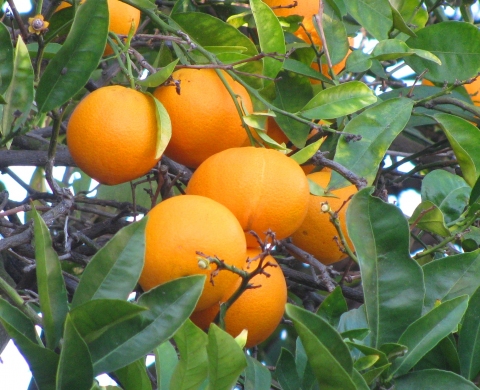Citrus sinensis (L.) Osbeck
C. sinensis tree grows in tropical, semitropical, and warm temperate regions, becoming the world's most widely cultivated citrus fruit tree. The tree is native to Asia and is now widespread throughout the Pacific and warm areas of the world. It is an evergreen flowering tree typically growing to 7.5 m, but occasionally reaching heights up to 15 m, consists of a compact crown with mostly spiny branches. Leaves are smooth, dark green, 3–5 mm wide, 6.5–15 cm long alternate with toothed blades differently shaped, oval or elliptical, connected to the stem by winged petioles. As copious oil is present in leaves radiates a strong characteristic citrus odor.
Flowers are small, waxy white, and fragrant which are axillary in whorls of 6 (5 cm wide) with five white petals and 20 to 25 yellow stamens.
Fruits are varied in their shape and size (from round to oblong). These are mostly greenish in color after gaining their full size it shows bright yellow to orange color instead of green. Fruits are round, 4–12 cm, consisting of a leathery peel 6 mm thick, tightly adherent, protecting the juicy inner pulp, which is divided into segments that may not contain seeds, depending on the cultivar. Fruits are full of flavor, fragrance, and juice .
The external coloured surface of the orange peel is called a flavedo, whereas an inner white spongy structure is called an albedo. Flavedo contains bags with essential oils (EO) mostly composed of limonene, whereas the albedo has a foamy structure and features a high content of pectin. Fruit is covered by skin-like tissue called an endocarp, which is composed of pulp and juice, where there are also membranes to delimit each of the segments. Peels are rich in structural polysaccharides and related polymers, including cellulose [18–20% w/w based on dry solid (DS)], hemicellulose (14–16% w/w DS), pectin (20–22% w/w DS) and lignin (5–7% w/w DS). It is also abundant in free sugars namely glucose, fructose, and sucrose (about30–36%w/w DS) as well as other components such as EO (0.3 –0.5% w/w DS) and proteins (up to 8% w/w DS), the peel being particularly plentiful in pectin (up to 42–43% w/w DS) .
- Family: Rutaceae
- Habit: Tree
- Habitat: Evergreen forests
- Status : Common
Vernacular names
English : Mosambi orange,Mosambique orange.
Medicinal Uses
C. sinensis is consumed all over the world as an excellent source of vitamin C, which is a powerful natural antioxidant that builds the body's immune system. It has been used traditionally to treat various ailments like constipation, cramps, colic, diarrhea, bronchitis, tuberculosis, cough, cold, obesity, menstrual disorder, angina, hypertension, anxiety, depression and stress, asthma, vomiting, fever, hiccoughs and for indigestion . In Chinese Traditional medicine, the orange has a long history as a cooling agent for coughs, colds, and respiratory disorders. It is used as a traditional symbol of good luck in China .
